Last updated on March 25th, 2022
Our site is reader supported, this means we may earn a small commission from Amazon and other affiliates when you buy through links on our site.
If you have stunning succulents already growing in your home or your garden, you might be interested in making more plants from the ones you already have rather than going out and buying more of them from a nursery. Not to mention it can be lots of fun. There are two ways that you can grow succulents from existing succulents. The first is using seeds, which can be a bit difficult and the second (and more popular way) is to grow succulents from cuttings. It is very easy to do and lots of people have success doing this.
Now you need to be mindful of the type of succulent you have because there are literally thousands of different varieties, and these varieties have different ways that you can propagate them. Some, like aloe vera plants, are easiest to propagate by division, literally cutting the plant in half and growing them in separate containers. Others can be cultivated by stem cuttings or leaf cuttings. This article will help you to grow succulents from cuttings, which we personally think is the best way to successfully propagate succulents.
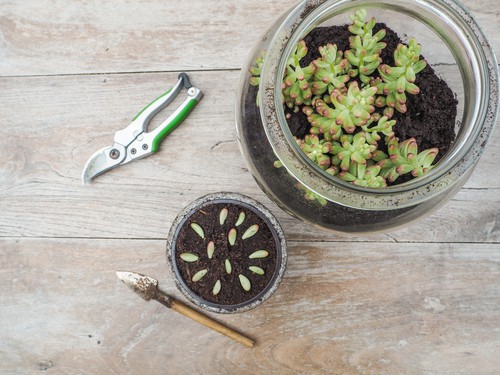
When to propagate succulents from cuttings
You want to propagate during the hottest part of the summer because this will bring the highest amount of success. You can, of course, propagate at any time of year but with the warm and humid weather, your succulent will respond better. In the UK you want to consider propagating succulents between June and September, however, don’t be afraid to try at other times of year too.
What you need to take a cutting from a succulent
When you are propagating your succulents from cuttings you will need some succulent potting soil, which you can buy from most garden centres or online, a sharp set of gardening snippers (scissors or a sharp knife will do just as well), clean containers or a propagator, and it will help if you to have plant rooting hormone although this isn’t essential because they also root well without.
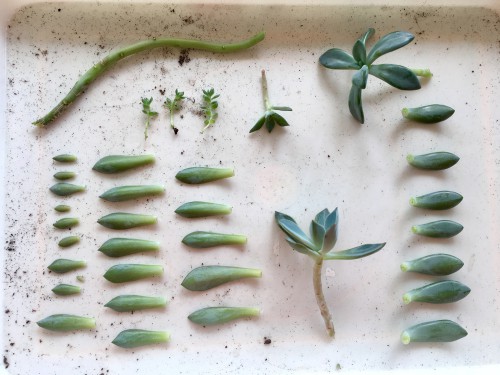
How to take stem cuttings from succulents
The fastest way to propagate a succulent is to take a stem cutting. You can take any sized stem and this means any plant clippings you take when you trim your succulents or any branches that naturally break off, and healthy stems can all be used as cuttings.
If you haven’t recently trimmed (and saved) part of your succulent you can purposefully make a cut. Decide where you want to make that cuts and use a sharp set of sterile tools such as snippers, scissors or a sharp knife to take a length of stem approximately 6-9cm in length. You can sterilise the tools you are using with a mixture of bleach and water or rubbing alcohol.
Just be sure that if you are taking cuttings from more than one plant, you dip the tool into whatever mixture you are using before moving on from one plant to another. This will simply help to prevent the spread of diseases in the open wound left behind from the cutting process.
You can simply break the pieces off your succulent by hand but using a sharp set of gardening secateurs is always recommended simply because it will ensure a swift and clean cut. If you break the stem off by hand it might leave a more jagged wound into which infection can spread.
Preparing the Stem Cuttings
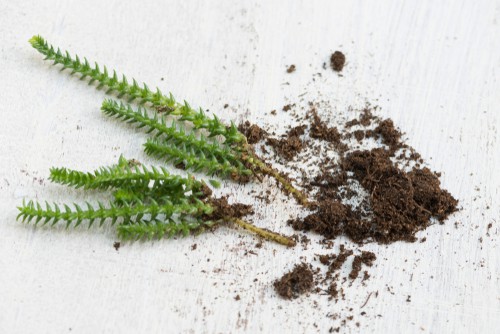
Once you have your cuttings in hand, as pictured above, it’s time to prepare them. You want to allow them to cure before you propagate. This simply means they need an opportunity to dry out and callus over where they were cut. Allowing them to do this for a few days will help to prevent rotting.
Note that succulents store moisture in their large leaves so the thicker the leaves on your stem, the longer it should be allowed to cure before you propagate.
How to take leaf cuttings from succulents
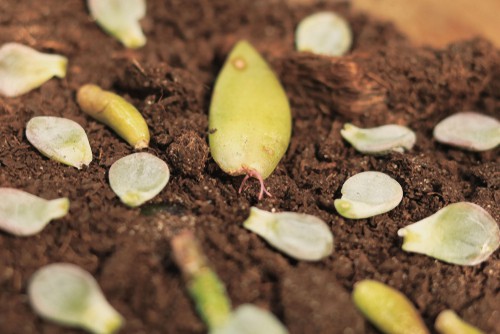
As mentioned you can also propagate using the leaves. If you propagate from a leaf it will take longer than propagating from a stem but it can be an equally rewarding process. For this process to work, however, you must break the entire leaf off the plant cleanly otherwise it won’t root. Some leaves will break off cleanly with just a slight touch but others need a gentle tug.
You want to hold the end of the leaf and wiggle it gently until it breaks off cleanly from the plant. This is something you might have to do more than once with more than one leaf if the first one breaks in half when you try to remove it from the plant. If this happens just discard the leaf and try again with another one.
If you are using leaf cuttings you don’t have to allow any time to cure.
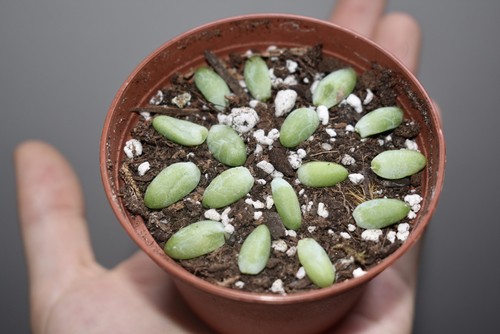
Rooting your cuttings in soil
Whether you use stem cuttings or leaf cuttings, we recommend dusting the end of the stem or the leaf with rooting hormone. This hormone will encourage a faster root system although it is not a necessity. If you just don’t have any or you can’t find it, you can still propagate without it.
Buy specially made succulent compost or make your own
When you are ready, fill your containers with succulent potting soil. Succulents do best in light, sandy soil mixtures that you can purchase specifically for this purpose. You could also make your own with a combination of potting soil, perlite and coarse sand.
 Compost ideal for growing cutting – Available from Amazon.co.uk
Compost ideal for growing cutting – Available from Amazon.co.uk
Placing the cuttings into the soil
Make a hole in the centre of the mixture with your finger (or a dibber, a pen, or pencil) and gently place the stem into the hole. You don’t want the rooting hormone to rub off during this process. Once that is done lightly pack the soil around the base of your cutting so that it is firmly in place and the soil is in contact with the stem. If you are growing from leaves, you can simply lay the leaves on top of the soil and put several in one pot if you have more than one, as pictured above.
Where to place your cuttings
With that done, place your cuttings in an area where they will be protected from direct sunlight and from rain. You want to keep your soil slightly on the dry side and to keep the air around humid. Be mindful of over-watering because if the soil gets too wet your cuttings will simply rot and they won’t actually produce any roots. So do not water the plants until they have established roots.
This won’t take more than a few weeks. The more humid the air and the drier the conditions, the faster it will take place. When you see new growth appearing on your cuttings it is indicative of roots being established. The leaves that you lay on top of the soil will start to sprout their roots and then grow small succulents at the base. For these, any exposed roots you see can be buried with a thin layer of soil, but be careful you do not accidentally bury the succulents that should have started to develop.
The biggest thing to remember when you are propagating from cuttings is not to water until the roots have formed. Even then you want to water sparingly and always allow the soil to dry out completely before you water again. The biggest cause of failure when propagating succulents is simply over-watering, remember succulents store water in their leaves.
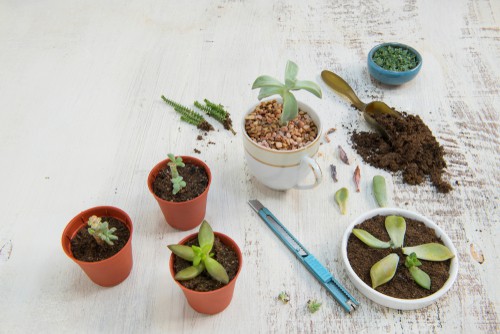
Repotting
Your succulent cuttings can live in these trays or containers for quite some time. In fact, all succulents thrive in smaller containers than you might think. But when it is time to re-pot them into their permanent home you always want to use a succulent potting mix that is sandy and fast-draining.
You can ensure that they don’t have problems with waterlogging by always using clay pots instead of plastic pots and adding extra drainage holes at the bottom with a layer of small grit at the bottom. Even when they are established you should be watering no more than once a week during the summer and less when the weather gets colder.
Image credits – Shutterstock.com


